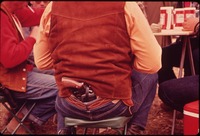THE POINT OF ALL THIS IS TO UNDERSTAND WHICH U.S. STATES ARE OPEN CARRY STATES AND WHICH ARE NOT.
Open carry in the United States
From Wikipedia, the free encyclopedia
(Redirected from Open carry)
See also: Concealed carry in the United States
United States, open carry refers to the practice of "openly carrying a firearm in public", as distinguished from concealed carry, where firearms cannot be seen by the casual observer.The practice of open carry, where gun owners openly carry firearms while they go about their daily business, has seen an increase in the U.S. in recent years.[1][2] This has been marked by a number of organized events intended to increase the visibility of open carry and public awareness about the practice.[3] Proponents of open carry point to history and statistics, noting that criminals usually conceal their weapons, a stark contrast to the law-abiding citizens who display their sidearms.[4] Encouraged by groups like The Modern American Revolution,[5] OpenCarry.org, GeorgiaCarry.org and some participants of the Free State Project, open carry has seen a revival in recent years,[6][7][8] but it is not yet clear if this represents just a short-term trend.[9][10]
The gun rights community has become supportive of the practice. Alan Gottlieb of the Second Amendment Foundation has been cautious in expressing support,[11] while special-interest groups such as the aforementioned OpenCarry.org and GeorgiaCarry.org, and certain national groups such as the NRA and Gun Owners of America (GOA) have been more outspoken in favor of the practice.
Open carry is strongly opposed by gun control groups such as the Brady Campaign and the Coalition to Stop Gun Violence.[12][13]
Contents
Terminology
| This section needs additional citations for verification. (November 2014) |
A man openly carrying a handgun at a fast food restaurant in Eagle, Colorado.
- Open carry
- The act of publicly carrying a firearm on one's person in plain sight.
- Plain sight
- Broadly defined as not being hidden from common observation; varies somewhat from state to state. Some states specify that open carry occurs when the weapon is "partially visible," while other jurisdictions require the weapon to be "fully visible" to be considered carried openly.
- Loaded weapon
- Definition varies from state to state. Depending on state law, a weapon may be considered "loaded" under one of the following criteria:
-
-
- Only when a live round of ammunition is in the firing chamber of the weapon
- When a magazine with ammunition is inserted into the firearm, regardless of whether or not a round is in the chamber
- When a person has both the firearm and its ammunition in his or her possession, without regard as to whether a round is in the chamber or a magazine with ammunition is inserted into the firearm (most common legal definition in "gun-control" states)
-
- Preemption
- In the context of open carry: the act of a state legislature passing laws which limit or eliminate the ability of local governments to regulate the possession or carrying of firearms.
- Prohibited persons
- This refers to people who are prohibited by law from carrying a firearm. Typical examples are felons, those convicted of a misdemeanor of domestic violence, those found to be addicted to alcohol or drugs, and those who have been involuntarily committed to a mental institution.
Categories of law
Today in the United States, the laws vary from state to state regarding open carry of firearms. The categories are defined as follows:
A hunter carrying a revolver in a visible rear holster.
- Permissive open carry states
- A state has passed full preemption of all firearms laws, with few exceptions. They do not prohibit open carry for all non-prohibited citizens and do not require a permit or license to open carry. Open carry is lawful on foot and in a motor vehicle. It must be noted that while open carry may be legal in such jurisdictions per se, persons openly carrying firearms may be detained and cited by law enforcement officials for disorderly conduct or disturbing the peace in certain locations and circumstances where openly carrying could cause public alarm.
- Licensed open carry states
- A state has passed full preemption of all firearms laws, with few exceptions. They permit open carry of a handgun to all non-prohibited citizens once they have been issued a permit or license. Open carry of a handgun is lawful on foot and in a motor vehicle. In practice however, some of these states that have May-Issue licensing laws can be regarded as Non-Permissive for open carry, as issuing authorities rarely or never grant licenses to ordinary citizens.
- Anomalous open carry states
- The legality of open carry varies within state, based on local policies (usually at the county level, but may also include incorporated cities and towns). In such states, some local jurisdictions may permit open carry while others may impose varying degrees of restrictions or prohibit open carry entirely.
- Non-permissive open carry states
- In these states, open carry of a handgun is not lawful, or is only lawful under such a limited set of circumstances that public carry is effectively prohibited. Such limited circumstances may include when hunting, or while traveling to/from hunting locations, while on property controlled by the person carrying, or for lawful self-defense. Additionally, some states with May-Issue licensing laws are Non-Permissive when issuing authorities are highly restrictive in the issuance of licenses allowing open carry.
- Rural open carry states
- In these states, open carry is generally prohibited, except in unincorporated areas of counties where population densities are below statutorily-defined thresholds, and local authorities have enacted legislation to not prohibit open carry in such jurisdictions (California). As such, these states are also regarded
- END QUOTE FROM:
- https://en.wikipedia.org/wiki/Open_carry_in_the_United_States



No comments:
Post a Comment